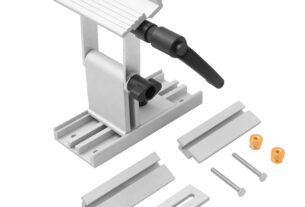Are you a DIY enthusiast looking for a versatile and efficient tool to level up your projects? Look no further than rotary tool attachments! With the ability to transform your rotary tool into a multifunctional instrument, these attachments are a must-have for any serious DIYer.
In this ultimate guide, we’ll take a deep dive into rotary tool attachments, discussing their benefits, types, and applications. Whether you’re a beginner or seasoned pro, this article will provide valuable insights and tips to enhance your DIY game.
Benefits of Rotary Tool Attachments
Rotary tools are already incredibly versatile, but when you add attachments, they become even more so. Here are some of the main benefits of using rotary tool attachments:
1. Versatility: Rotary tool attachments can perform various tasks such as sanding, polishing, cutting, engraving, and drilling. They allow you to work on different materials such as wood, metal, plastic, and ceramics with ease.
2. Precision: Most rotary tool attachments are designed to be precise and accurate. They enable you to work on intricate details and small spaces that would otherwise be impossible to access.
3. Efficiency: Rotary tool attachments can save you time and effort by providing quick results without compromising quality. They also reduce the need for multiple tools and equipment.
4. Cost-effective: By investing in one high-quality rotary tool and multiple attachments, you can save money compared to buying several specialized tools separately.
Types of Rotary Tool Attachments
There is a vast range of rotary tool attachments available in the market today. Here are some of the most common types:
1. Sanding Discs: Used for sanding flat surfaces or rounding edges.
2. Grinding Stones: Used for grinding and sharpening tools or removing rust from metal surfaces.
3. Cutting Wheels: Used for cutting through different materials such as metal, wood, and plastic.
4. Polishing Wheels: Used for polishing and buffing surfaces to a high shine.
5. Engraving Cutters: Used for engraving designs or lettering on different materials.
6. Drill Bits: Used for drilling holes in various materials such as wood, metal, and ceramics.
Applications of Rotary Tool Attachments
Rotary tool attachments can be used in various DIY projects and applications. Here are some examples:
1. Woodworking: Rotary tool attachments can be great for carving, sanding, and shaping wood. They can also be used to drill holes and make intricate cuts.
2. Metalworking: Rotary tool attachments can be used to polish metals, sharpen tools, and remove rust from surfaces.
3. Jewelry Making: Rotary tool attachments can be used to engrave designs on metals or carve gemstones.
4. Home Improvement: Rotary tool attachments can be used for tasks such as cutting tiles, grinding mortar, or polishing surfaces.
5. Auto Repair: Rotary tool attachments can be used to remove rust from car parts, polish headlights, or sharpen blades.
Conclusion
In conclusion, rotary tool attachments are an excellent investment for any DIY enthusiast looking to enhance their projects’ efficiency and versatility. With the ability to perform multiple tasks on different materials with precision and accuracy, these attachments are sure to up your game.
Remember that choosing the right attachment for your project is crucial. Always read the manufacturer’s instructions carefully before use and wear appropriate safety gear such as goggles and gloves.
If you’re looking to purchase rotary tool attachments, do your research beforehand and consider factors such as compatibility with your rotary tool and the specific task you need it for.
We hope this ultimate guide has provided valuable insights into rotary tool attachments and how they can benefit your DIY projects. Happy crafting!
References:
– https://en.wikipedia.org/wiki/Rotary_tool
– https://www.dremel.com/products/attachments




